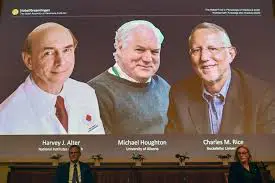Home Hepatitis C nobel prize
Earlier this month the Nobel Prize in Physiology and Medicine was jointly awarded to Harvey J Alter, Michael Houghton and Charles M Rice for the discovery of the Hepatitis C virus
Earlier this month the Nobel Prize in Physiology and Medicine was jointly awarded to Harvey J Alter, Michael Houghton and Charles M Rice for the discovery of the Hepatitis C virus. This helped push our understanding of blood-borne hepatitis, a major global health problem that is one of the leading causes of cirrhosis and liver cancer alongside Hepatitis B. It led the way in introducing new tests for chronic hepatitis as well as new treatments that have saved the lives of millions.
HEPATITIS
Hepatitis is the inflammation of your liver, the largest solid organ in your body. Though there are numerous other causes of hepatitis, including alcohol abuse, drugs and toxins (including paracetamol overdose), and autoimmune disorders (such as Wilson’s disease), viral infections are the most common worldwide causes for hepatitis. Hepatitis A was the first to be discovered, transmitted by polluted food and water, and results in a short-term transient hepatitis. Hepatitis B on the other hand is transmitted through blood and is more of an issue as it can lead to chronic cirrhosis and possible liver cancer. It can remain indolent in a person, causing disease long after the initial infection.
Blood borne hepatitis was first discovered in the 1960s, when it was found that some patients would become ill after receiving blood transfusions. Despite this discovery and new tests for Hepatitis B reducing the number of transfusion related hepatitis, a large number of cases remained.
NOT A, NOT B
Harvey Alter, working at the US National Institute of Health, was studying the occurrence of hepatitis in blood transfusion patients. His team showed that blood from these infected patients could transmit the disease to chimpanzees, resulting in hepatitis. This agent had the properties of a virus, one that was “non-A, non B” hepatitis.
Further investigation into the virus would require the input of Michael Houghton, working for Chiron pharmaceutical. His team created a collection of DNA fragments found in the blood of infected chimpanzees. Though the majority of these fragments were from the chimpanzee, enough were from the virus. They were able to utilise this information to identify antibodies against the suspected virus, and ultimately identify it as the flavivirus Hepatitis C.
The final piece of the puzzle was shown by Charles M Rice, a researcher at Washington University, St Louis – could the virus alone cause hepatitis. He studied the RNA of Hepatitis C to identify regions that may be used for replication, and areas that might hinder replication. This was key as the virus can lay dormant for years, replicating at a slow rate before causing damage to the liver. For researchers, this was an issue as it was not feasible to wait years and see if the suspected virus caused hepatitis. By genetically engineering the viral genome, he developed a variant of Hepatitis C that would only multiple rapidly and have no mechanism to inactivate itself for dormancy. This strain caused rapid changes to the livers of infected chimpanzees; the same changes seen in hepatitis patients.
. ;.,hrvxzThe impact was significant. Prior to this, receiving a blood transfusion was like Russian Roulette. You were receiving life saving therapy, but it coZuld also be a hidden death sentence. Now that hepatitis had been discovered, it became possible to screen patients prior to donation, to screen blood transfusion bags, and to start developing treatments for the virus.
The fight is not over yet. There are still over 70 million people who still live with the virus, and it still kills around 400,000 a year. Its only very recently that we have found treatments that can reduce the viral load in patients to levels that they are considered cured. This treatment remains expensive, and we are very far away from eradication itself.
Recent Posts
why fatigue should not be ignored
Dec 30,2025









